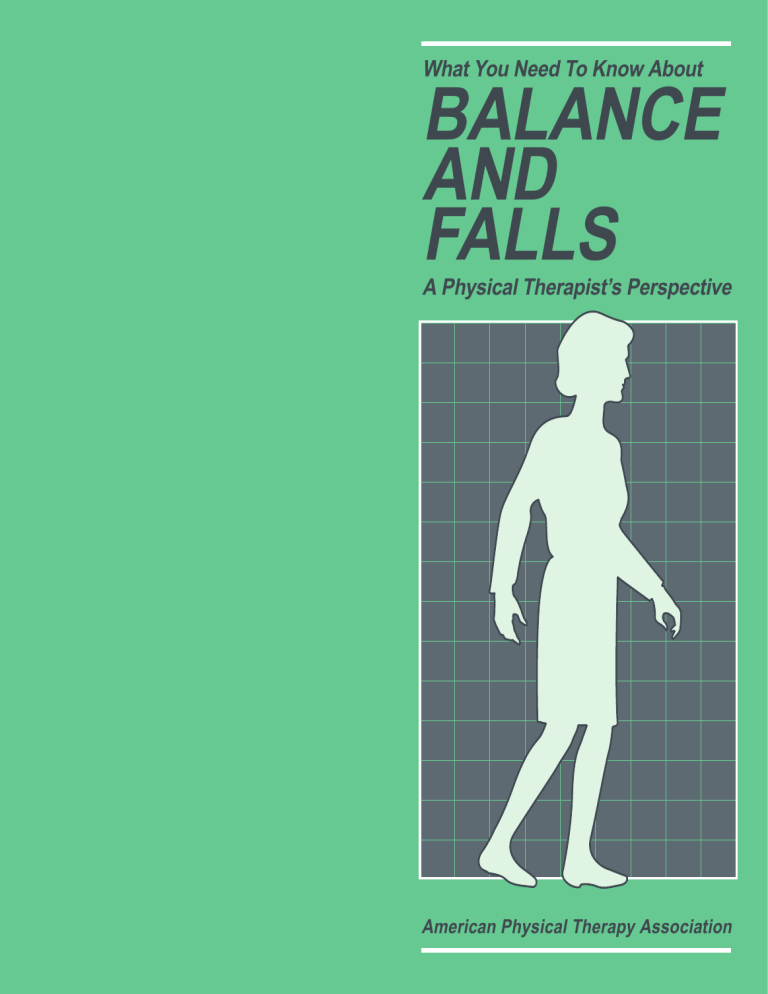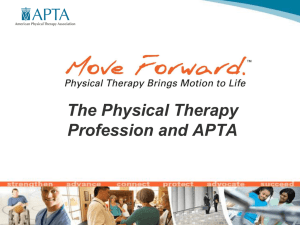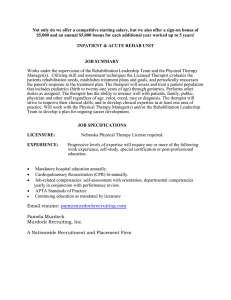
What You Need To Know About BALANCE AND FALLS A Physical Therapist’s Perspective American Physical Therapy Association What You Need To Know About Balance And Falls A ©1999 APTA All rights reserved. This brochure is not intended as a substitute for professional health care. nyone who has ever slipped on a patch of ice knows how unnerving it can be to lose your balance—for a moment your world is literally turned upside down. Yet balance—the ability to control and maintain your body’s position as it moves through space—is such an integral, ever-present part of daily life that most people rarely give it conscious thought. There are conditions, however, that may impair your sense of balance and contribute to falls. The effects of aging are the most common causes of balance problems; injury and disease can also trigger problems. Because falling is such a common and 1 potentially serious problem—1 in 4 people over the age of 65 (who live at home) will fall during the next year—it’s important to find out what you can do to decrease your risk and improve your general health and mobility. In this booklet we will discuss: • How your body maintains its balance; • Common problems with balance seen in older adults; and • Advice and exercises for improving balance and preventing falls. How Balance Works our brain, muscles, and bones work together to maintain your body’s balance and to keep you from falling, whether you’re walking, rising from a chair, or climbing stairs. They also let you navigate sloping or uneven surfaces. Balance relies on three types of sensory information. The first of these is visual: Your eyes tell you about your environment and Y your place within it. They help you sense obstacles and potential dangers, and form motor memories that prevent falls. The second type of sensory information comes from your body’s internal sense of spatial orientation, independent of vision. This allows you, for example, to close your eyes and then wiggle your foot in any direction, “All Fours” Balance Exercise 1. Get on all fours, with your knees and also your hands 12-18 inches apart—like a table. 2. Pull your stomach muscles in tight. Keep your shoulders pinched back and your back flat. 3. Keep your chin “in” and your head “straight.” 4. Now lift each arm by itself and hold for 3-10 seconds. 5. Return arms to floor. Now lift each leg by itself, no more than 6” off the floor. Hold for 3-10 seconds. 6. Finally, lift the opposite arm and leg together no more than 1” and hold for 3-10 seconds. Reach out only if you feel steady. Repeat on opposite sides. Drugs, Alcohol, And Balance ertain drugs (including tranquilizers, heart medicines, blood pressure medicines, and mood-altering drugs) and alcohol are major culprits when it comes to increased risk of falling because drowsiness, dizziness, and slowed reflexes are common side effects. Be especially aware of potentially dangerous drug interactions when taking multiple drugs (including over-the-counter medications and/or alcohol). C 2 3 Toe, Heel, And Leg Rises A while still knowing which way your foot is 1. Stand straight and tall, with your knees slightly pointed. The third bent and your toes pointed type of sensory straight ahead. Line your information is proknees up over the point of vided by your your shoes. inner ears, which 2. Look straight ahead. Keep your chin tucked and contain fluid-filled semicircular canals. your shoulder blades These canals propinched straight back. Tighten your stomach vide your brain and muscles. eyes with crucial 3. (A) Rise up on your information on toes. Lower yourself back B the position of down and repeat. your head and its 4. (B) Keep your posture movement in space the same. This time, how- with respect to ever, raise the front part of gravity. (Common your foot, lower, and repeat. Remember to keep problems related to the workings of the your stomach muscles tight. inner ear include dizziness on esca5. (C) Keep standing straight and tall, as before. lators and sea-sickShift your weight forward ness.) When your to the front half of your sense of balance is feet. Lift one leg, keeping in good workyour standing leg in proper C ing order, the alignment. Hold 10-30 secthree elements of onds. Lower and repeat balance work with the other side. together automati6. Slowly and carefully repeat each exercise 3-5 cally with your mustimes. culoskeletal system to keep you mobile and to prevent falls. There are various reasons why 4 your sense of balance can become impaired. In older adults, poor posture—particularly if you tend to slouch forward and have rounded upper shoulders—can sometimes cause unsteadiness. Furthermore, your base of support is important in keeping you balanced: if you have a wide “pyramid”-type stance, you’re less likely to lose your balance or fall than if your feet are close together in a “pencil” stance. Disease can also rob you of a strong sense of balance. People with diabetes, for example, may suffer from numbness in the lower extremities and feet—a problem that makes detecting obstacles or dangers more difficult. People with arthritis, or who have had surgery on their hips, knees, or Eye Exercise For Balance 1. Focus your eyes on a target 10-20 feet away while you change from sitting to standing and back again with your eyes OPEN. Make sure that you land softly when you sit! 2. Repeat with your eyes CLOSED. 3. Feel the position of your body as you move. Be sure that you keep your weight forward on the front of your feet, knees apart, chest forward, and spine erect. 5 feet, may lack the flexibility and range of motion necessary to avoid falling. Strength, flexibility, and endurance are crucial to maintaining balance and preventing falls. Even if your basic perception of balance is good—you have normal vision and no Half-Circle Sway If you have experienced falls or problems with balance, get your physical therapist’s permission before doing this exercise. 1. Stand with your feet shoulder-distance apart. Hold onto the kitchen sink counter for safety. Breathe deeply and relax. 2. Lean forward slowly from the ankles, without bending at the hips. Feel how about 70% of your body weight is now on the balls of your feet. 3. Return to the neutral starting position. Now, lean slowly to the left. Feel how about 70% of your body weight is on the left sides of your feet. 4. Return to the upright position. This time lean slowly to the right, feeling the shift in your weight. 5. Now put it all together: Practice making graceful half-circle sways from left to center to right and back again. Begin with small half circles, and gradually increase to see how far you can move your body without taking a step. 6 inner ear problems—you can still be at risk for falls if your muscles are weakened or stiff, or if you tire easily. Older adults—particularly those with osteoporosis (the disease that causes brittle bones)—have very legitimate concerns about falling and often restrict their physical activities to prevent such a mishap. Ironically, lack of exercise only makes it more likely that a fall will occur—and a vicious cycle has been put into motion. Fortunately, physical therapy can help you learn to cultivate and maintain higher levels of strength, flexibility, and endurance in a way that still feels safe and secure. Research indicates that the risk of falling in older adults can be reduced dramatically when specific exercises, activities, and interventions are prescribed by physical therapists. There are instances, however, in which physical therapy alone may not be appropriate. If you have an inner ear disorder, for example, you will need to consult a physician. Making Your Home Safer reventing falls is easier than treating them. Your physical therapist can help you evaluate your home environment with the goal of minimizing clutter, loose rugs, slippery conditions, uneven surfaces, and unsecured cords and wires—in short, anything that could cause a fall. Good lighting and wellthought-out placement of furniture can also help prevent mishaps. P 7 How Physical Therapy Can Help f you consult a physical therapist about falls and balance, he or she will likely review your medical history and determine your gen- I Tai Chi The ancient martial art of tai chi has become very popular in the West in recent years, and classes are often available through community colleges, local recreation centers, YMCAs, community centers, etc. Research has shown that people of all ages—including older adults— often find it to be helpful in promoting balance and preventing falls. An added bonus is that tai chi may add to your sense of emotional well-being. 8 eral physical condition, as well as conduct an inventory of tests specifically designed to measure balance and gait (your individual style of walking). If you have fallen before, your physical therapist will ask you to describe the accident in some detail to find out what caused the fall. (Just as important as actual falls are “near-falls”—instances in which you were on your way down but managed to “hang on.”) After your physical therapist has determined what is impairing your balance, he or she will design a program of exercises and activities just for you, with an emphasis on strength, flexibility, and proper gait. All exercises would be planned for maximum safety and security. Your physical therapist may also perform specific interventions to increase your range of motion and musculoskeletal flexibility. These may include electrical stimulation, massage, hydrotherapy, heat, cold, and ultrasound. If you have balance problems related to the inner ear, your physical therapist may also try interventions known as vestibular rehabilitation. Vestibular rehabilitation includes techniques that help the inner ear respond to a change in position. Conditions that may require vestibular rehabilitation include vertigo, dizziness, or nausea. If necessary, your physical therapist may also prescribe assistive devices for walking (such as canes, crutches, or walkers). Make sure the tips on canes and crutches are large (and spiked, if necessary, for icy conditions), and that canes are high enough (they should come up to your hip). Appropriate footwear is another major con9 sideration. Wearing a good pair of lace-up walking shoes will help support your foot and provide necessary cushioning for your joints; this will make walking safer and more comfortable. Avoid high heels, slippers, and opentoed sandals, which can cause you to trip. Balance Is A Skill You Can Keep—Or Recapture he good news is that balance is a skill that almost all of us can keep throughout our lives. Much of the deterioration in balance associated with age is simply due to not using T this skill. Sometimes this happens because of change in lifestyle—most of us become more sedentary as we grow older—or it can happen due to fear of falling. Working with a physical therapist can produce exceptional results in many cases. Even if some of your innate sense of balance has been diminished over time, physical therapists are experts at retraining your body to make the most of its capabilities. About APTA The American Physical Therapy Association (APTA) is a national professional organization representing more than 74,000 members. Physical therapists are vital members of the multidisciplinary health care team. They provide treatment and can refer clients to other health care specialists. APTA serves its members and the public by promoting understanding of the physical therapist’s increasing role in the health care system. APTA also promotes excellence in the field with improvements in physical therapy education, research, and practice. Acknowledgments Dale Avers, MSEd, PT Carleen Lindsey, PT In Your Physical Therapist’s Office Your physical therapist has many ways of working with you to enhance your sense of balance. Pictured here is a patient practicing balance skills using a therapeutic ball. 10 Other APTA Brochures ❑ Fitness: A Way Of Life ❑ For The Young At Heart: Exercise Tips For Seniors ❑ For Women Of All Ages ❑ Taking Care Of Your Back 11 ❑ Taking Care Of Your Foot And Ankle ❑ Taking Care Of Your Hand, Wrist, And Elbow ❑ Taking Care Of Your Hip ❑ Taking Care Of Your Knees ❑ Taking Care Of Your Shoulder ❑ The Secret Of Good Posture ❑ What You Need To Know About Carpal Tunnel Syndrome ❑ What You Need To Know About Arthritis ❑ What You Need To Know About Neck Pain ❑ What You Need To Know About Osteoporosis ❑ You Can Do Something About Incontinence Bulk quantities available. See the APTA Resource Catalog at svcctr©apta.org or send your request by mail to APTA, 1111 North Fairfax Street, Alexandria, VA 22314-1488. 12 Prepared as a public service by the American Physical Therapy Association 1111 North Fairfax Street Alexandria, VA 22314-1488 40-M/PR-247/5-99 x x


